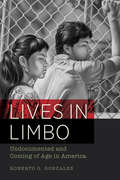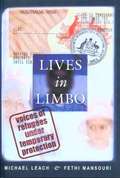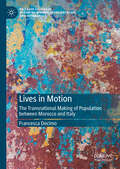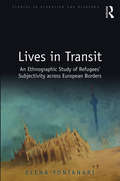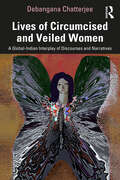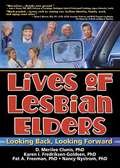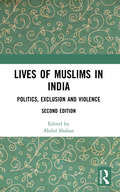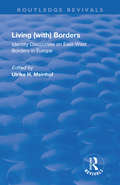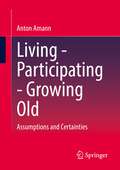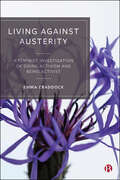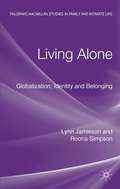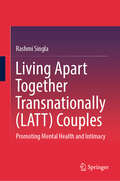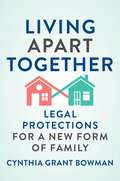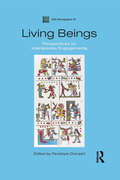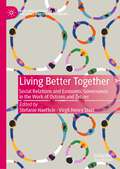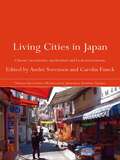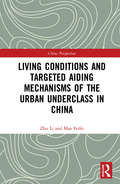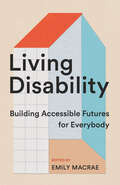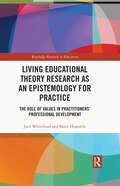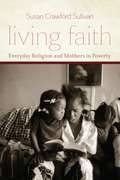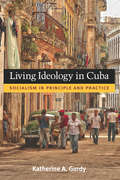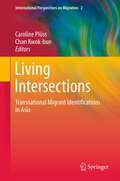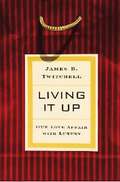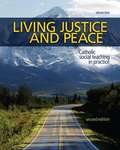- Table View
- List View
Lives in Limbo
by Roberto G. Gonzales"My world seems upside down. I have grown up but I feel like I'm moving backward. And I can't do anything about it." -Esperanza Over two million of the nation's eleven million undocumented immigrants have lived in the United States since childhood. Due to a broken immigration system, they grow up to uncertain futures. In Lives in Limbo, Roberto G. Gonzales introduces us to two groups: the college-goers, like Ricardo, who had good grades and a strong network of community support that propelled him to college and DREAM Act organizing but still landed in a factory job a few short years after graduation, and the early-exiters, like Gabriel, who failed to make meaningful connections in high school and started navigating dead-end jobs, immigration checkpoints, and a world narrowly circumscribed by legal limitations. This vivid ethnography explores why highly educated undocumented youth share similar work and life outcomes with their less-educated peers, despite the fact that higher education is touted as the path to integration and success in America. Mining the results of an extraordinary twelve-year study that followed 150 undocumented young adults in Los Angeles, Lives in Limbo exposes the failures of a system that integrates children into K-12 schools but ultimately denies them the rewards of their labor.
Lives in Limbo: Voices of Refugees Under Temporary Protection
by Michael Leach Fethi MansouriIn this book, 35 refugees, all temporary protection visa (TPV) holders and mostly from Iraq and Afghanistan, talk directly about their quest for asylum in Australia. They provide poignant details of persecution in their home country, their journey to Australia, prolonged periods of mandatory detention, and life under Australia's controversial temporary protection regime.
Lives in Motion: The Transnational Making of Population between Morocco and Italy (Palgrave Studies in Mediating Kinship, Representation, and Difference)
by Francesca DecimoThis book focuses on global mobility and the worldwide articulation of family life, understood as dimensions of social change that come off from the private sphere of individuals and reverberate to the point of transforming the composition of national populations. Delving into the interrelation of migration and life courses, the volume investigates how individual mobility paths are intertwined with family matters and the way population movements are embedded in a myriad of intimate and household affairs. The inquiry is based on qualitative data and specifically focused on the migratory flow between Morocco and Italy through an exploration that encompasses a range of interrelated issues such as: transnational marriages, intimacy, love, daily domestic life, the formation of second generations and citizenship. Providing an exhaustive analysis of such phenomena, the book portrays cultural diversity in a nuanced manner and, in so doing, contributes to de-politicize widely stigmatized traits of migrant families.
Lives in Transit: An Ethnographic Study of Refugees’ Subjectivity across European Borders (Studies in Migration and Diaspora)
by Elena FontanariThis book explores the border-crossing mobilities of refugees within Europe. Based on ethnographic fieldwork in Germany and Italy, it examines the precarious everyday lives of non-citizens living between and beyond EU internal borders. With attention to the constant re-construction of borders within Europe through negotiation practices, the author shows how the tensions that exist between refugees on the move and the structural constraints that limit their movement produce ‘interstices’ – small spaces of possibility that open up as a result of refugees’ struggling within structural constraints. A comprehensive understanding of the long-term effects of EU borders upon refugees’ lives is then afforded through a particular focus on the post-arrival period. Examining the protracted precariousness and multi-directional hyper-mobility in Europe that emerges from the dynamics of the relation between structural mechanisms and the agency of individuals, Lives in Transit reveals how the border regime in Europe impacts mostly upon the temporal rather than the spatial dimensions of refugees’ lives, affecting their subjectivities and sense of self. This ‘dispossession’ of time is advocated as the main problem with the experience of refugees in Europe, causing them to claim a temporal justice, which seeks to gain back control of their own lives and personhood. Calling for migration to be understood as a process of ‘becoming subjects’, this volume will appeal to scholars of sociology, anthropology, and politics with interests in migration and diaspora studies.
Lives of Circumcised and Veiled Women: A Global-Indian Interplay of Discourses and Narratives
by Debangana ChatterjeeThe book unravels the politics of representation and the process of exoticising women’s bodies through the prism of external gaze and knowledge production. It brings out the intricacies of representational discourses around cultural practices of female circumcision (FC)/female genital cutting (FGC) and Islamic veiling. Focusing on crucial international legal texts and national legislation, the book gives an overview of the cultural nuances in FC/FGC and juxtaposes it with the Indian variation, khafz. The author studies the international veiling narratives that conjure up a fractured discourse containing aspects of colonialism, Islamophobia, and Islamic fashion and maps them with the regional variations of Islamic purdah in India. The volume explores the cultural practice of khafz and purdah through narratives in India, portraying how representational factors from international discourses reflect on the Indian context and vice versa. Amid the world of binaries and polarised opinions, the book offers a nuanced analysis of the space in-between, characterised by narratives from women. By situating women’s narratives in relation to family, community, state, and international politics, the book explores the global-Indian interplay of discourses on FC/FGC and Islamic veiling. This volume will be of interest to scholars, students, and readers of gender studies, feminism, cultural and religious studies, sociology, South Asian studies, and International Relations.
Lives of Lesbian Elders: Looking Back, Looking Forward
by D. Merilee Clunis J Dianne Garner Pat A. Freeman Nancy M. Nystrom Karen I. Fredriksen-GoldsenThe untold history of lesbian life from those who have lived it! Lives of Lesbian Elders: Looking Back, Looking Forward illuminates the hopes, fears, issues, and concerns of gay women as they grow older. Based on interviews with 62 lesbians ranging in age from 55 to 95, this very special book provides a historical account of the shared experiences of the lesbian community that is so often invisible or ignored in contemporary society. The book gives voice to their thoughts and feelings on a wide range of issues, including coming out, identity and the meaning of life, the role of family and personal relationships, work and retirement, adversity, and individual sources of strength and resilience. Cast off and overlooked at best or victims of scorn and prejudice at worst, lesbians in the twentieth century lived dual lives, their full voices unheard-until now. Lives of Lesbian Elders chronicles the life choices they made and their reasons for making them, set against the contexts of culture, politics, and the social mores of the eras in which they lived. Their stories of courage, resilience, resourcefulness, pride, and independence help restore lesbian history that has been forgotten, distorted, or disregarded and provide the information necessary to meet the future needs of aging lesbians. Lives of Lesbian Elders gives aging lesbians a chance to discuss their thoughts on a variety of topics, including: Coming out "You didn&’t talk about it . . . Until two years ago, I never even referred to a lesbian or would I allow the word to pass my lips" "I used to sneak into libraries and read about homosexuality and back in that era, it was not classy . . . it was classified as a disorder of some type" Identity "The only difference between me and anybody else is that I just happen to be sleeping with a woman" "I think I grew up not really knowing who I was and, I think, probably fighting all my life trying to find out who I was" Family "I feel very connected with the lesbian community here . . . I guess I would call that family" "Many years ago, my sister said: &’I think when they&’re ready, you need to explain to (the nieces) what a lesbian is, because I want them to hear the correct story . . . I want them to hear what it really is and not all these stupid rumors that go around&’" Work "I was going to become a youth minister at one point and it dawned on me in high school that there was no way the church was going to let me work with kids" "I didn&’t really finish my career . . . I still have dreams about the military and about not finishing . . . It was my choice, but it wasn&’t really my choice" Aging and the Future "I think financing, of course, is a real big problem for lesbian women" "I have a concern that if anything should happen to my partner-in growing older-of being isolated from the gay community" . . . and much more! Lives of Lesbian Elders: Looking Back, Looking Forward also includes appendices that present demographic data on the women who were interviewed for the book, information on historical timelines, and suggested readings on lesbian history. The book is an invaluable addition to the growing collective history of lesbians in the United States.
Lives of Muslims in India: Politics, Exclusion and Violence
by Abdul ShabanThe fast-consolidating identities along religious and ethnic lines in recent years have considerably ‘minoritised’ Muslims in India. The wide-ranging essays in this volume focus on the intensified exclusionary practices against Indian Muslims, highlighting how, amidst a politics of violence, confusing policy frameworks on caste and class lines, and institutionalised riot systems, the community has also suffered from the lack of leadership from within. At the same time, Indian Muslims have emerged as a ‘mass’ around which the politics of ‘vote bank’, ‘appeasement’, ‘foreigners’, ‘Pakistanis within the country’, and so on are innovated and played upon, making them further apprehensive about asserting their legitimate right to development. The important issues of the double marginalisation of Muslim women and attempts to reform the Muslim Personal Law by some civil society groups is also discussed. Contributed by academics, activists and journalists, the articles discuss issues of integration, exclusion and violence, and attempt to understand categories such as ‘identity’, ‘minority’, ‘multiculturalism’ and ‘nationalism’ with regard to and in the context of Indian Muslims. This second edition, with a new introduction, will be of great interest to scholars and researchers in sociology, politics, history, cultural studies, minority studies, Islamic studies, policy studies and development studies, as well as policymakers, civil society activists and those in media and journalism.
Living (with) Borders (with) Borders (with) Borders (with) Borders (with) Borders (with) Borders (with) Borders (with) Borders: Identity Discourses on East-West Borders in Europe: Identity Discourses on East-West Borders in Europe
by Ulrike H. MeinhofThis title was first published in 2002. Most nation states in Europe have undergone dramatic social and political upheaval with the construction of new or the redefinition of existing national borders. This book uses discourse analytical methods to focus on and unravel the complex cultural identities of people living in communities that straddle the border stretching from the Adriatic to the Baltic Sea.
Living - Participating - Growing Old: Assumptions and Certainties
by Anton AmannLife must be understood as the result of evolution, and human life as the emergence of the species Sapiens from the genus Homo of the family of apes. If the emergence of human life as an evolutionary fact is coupled with the notion of social life, we are referred to the constructive production of human life forms, of which social participation is an integral part. On the one hand, participation is tied back to the phylogenesis of the species Sapiens, but on the other hand, it has to be newly acquired and practiced by every human being in the process of ontogenesis, depending on the environment. Participation in old age is a separate specification of the conditions of this process and can be illustrated on the basis of a large number of empirical findings.
Living Against Austerity: A Feminist Investigation of Doing Activism and Being Activist
by Emma CraddockWith austerity’s disproportionately heavy impact on women now apparent, this engaging book considers activism against it from a feminist perspective. Emma Craddock goes deep inside activist culture to explore the many cultural and emotional dimensions of political participation. She questions what motivates and sustains protest, considering the enabling aspects of solidarity and empathy, as well as the constraining factors of negative emotions and gendered barriers associated with activism, examining the role of gender and emotion within protest. This is a lived-in study that gets to the heart of what it means to be an anti-austerity activist and an important addition to social justice debate.
Living Alone
by Lynn Jamieson Roona SimpsonIn Northern Europe almost half of households consist of one person. Rates of living alone are lower in the Global South but the trend is still on theincrease. Prevalent first among the elderly, living alone then becomes common at ages associated with partners and children. Fears about the end of family and community combine with stereotypes, the 'sad and lonely' or 'selfish singles', in popular depictions. This groundbreaking and highly original study brings evidence to the core debates about contemporary social change in the context of globalization, exploringindividualization and social connection, the future of family formation, consumption and identities, the relevance of place - rural or urban -in mobile worlds, sexuality, belonging and 'community', living arrangements and sustainability. This book presents a systematic sociological analysis of the growing trend of solo living across the globe, while also drawing on the voices of working-age men and women living in urban and rural areas in the UK. "
Living Apart Together Transnationally (LATT) Couples: Promoting Mental Health and Intimacy
by Rashmi SinglaThis book provides deep insight into intimacy and distance in the complex, globalised world through the newly coined concept of couples living apart together transnationally (LATT). Based on a review of the past four decades’ seminal studies and narratives from a qualitative empirical study, including both heterosexual and same-sex couples, it shows intimacy can be maintained without geographical proximity. The book has a rich, layered, and nuanced exploration of LATT couples' experiences of relationship maintenance across distance and time through diverse ways, such as digital emotions, online sexual activity, and meaning–making through spirituality, which challenge existing Eurocentric conceptualisations of intimacy and relationships. It also reveals an array of “good practices” for relationship maintenance across countries, which can inspire other couples and practitioners. Thus, the book is an important resource, not only for academics in the disciplines of psychology, anthropology, cultural studies, family science, sociology, migration, and communication but particularly useful for practitioners dealing with couple relationships, such as counselors, social workers, and mental health advisors. It is also relevant for international organizations and multinational corporations working with couples living apart together transnationally.“The implications of this book for ‘how we live now’ are clear – in a more closely connected and mobile world, the possibility of living our most intimate relationships across distance will affect increasing numbers of us… the book’s informative, theoretical, and practical messages have valuable lessons for many of us now and in the future.”Dr Lucy Williams,University of Kent, the UK· “Living Apart Together Transnationally (LATT) Couples: Promoting mental health and intimacy” gives us insights into the everyday lives of couples living apart together (LAT) in a contemporary world characterized by globalisation, and pandemics that have affected border controls and migration policies in different countries. Rashmi Singla invites us to challenge the way we understand intimate relationships that are connected to physical proximity and provides us with innovative ways to maintain emotional and physical intimacy despite geographical separation. Sayaka Osanami TörngrenAssociate Professor of International Migration and Ethnic Relations, Malmö University, SwedenDr. Rashmi Singla’s book “Living Apart Together Transnationally” addresses a very important problem many modern couples encounter living apart in different countries. The increasing globalization of the job market and mass migration in the past four decades have made this topic more important than ever before. However, research about love and life in such conditions is still limited. The research presented in this book reveals some new qualitative research findings about how partners maintain health and intimacy in such challenging conditions. This book presents novel and invaluable research for scholars in the area of love and couple relationships. Victor Karandashev, Ph. D.,Professor of Aquinas College, Michigan, The U.S.A.Dr. Rashmi Singla's work, 'Living Apart Together Transnationally (LATT),' stands as a profoundly empirical exploration of long-distance couples spanning international borders. The book provides captivating revelations into the lives, intimacies, and spiritual dimensions of such relationships. Offering an interdisciplinary approach, it establishes a robust groundwork for further investigations in this emerging field. Lise Paulsen Galal, PhD, Associate Professor in Intercultural Studies, Roskilde University, Denmark.How important is proximity in intimate relationships when partners live apart in different countries? This question sits at the core of this timely book, which offers new insights, in part
Living Apart Together: Legal Protections for a New Form of Family (Families, Law, and Society #15)
by Cynthia Grant BowmanArgues for legal reforms to protect couples who live apart but perform many of the functions of a familyLiving Apart Together is an in-depth look at a new way of being a couple and “doing family”—living apart together (LAT)—in which committed couples maintain separate residences and finances. In Bowman’s own 2016 national survey, 9% of respondents reported maintaining committed relationships while living apart, typically spending the weekend together, socializing together, taking vacations together, and looking after one another in illness, but maintaining financial independence. The term LAT stems from Europe, where this manner of coupledom has been extensively studied; however, it has gone virtually unnoticed in the United States.Living Apart Together aims to remedy this oversight by presenting original research derived from both randomized surveys and qualitative interviews. Beginning with the large body of social science literature from outside the US, Cynthia Bowman examines the prevalence of this lifestyle, the demographics of people who live apart, their reasons for doing so, and how these individuals manage finances, care during illness, and many other aspects of family life. She focuses in particular detail on three key demographics—women, gay men, and the elderly—and how individuals from these groups engage in LAT behavior. She finds that while these living arrangements are more common than previously believed, there are virtually no legal protections for the people involved. Bowman concludes by proposing a number of legal reforms to support the caregiving functions LAT partners perform for each other. Living Apart Together makes an important case for formal recognition of this growing but largely overlooked family structure.
Living Beings: Perspectives on Interspecies Engagements (ASA Monographs)
by Penelope DransartLiving Beings examines the vital characteristics of social interactions between living beings, including humans, other animals and trees.Many discussions of such relationships highlight the exceptional qualities of the human members of the category, insisting for instance on their religious beliefs or creativity. In contrast, the international case studies in this volume dissect views based on hierarchical oppositions between human and other living beings. Although human practices may sometimes appear to exist in a realm beyond nature, they are nevertheless subject to the pull of natural forces. These forces may be brought into prominence through a consideration of the interactions between human beings and other inhabitants of the natural world.The interplay in this book between social anthropologists, philosophers and artists cuts across species divisions to examine the experiential dimensions of interspecies engagements. In ethnographically and/or historically contextualized chapters, contributors examine the juxtaposition of human and other living beings in the light of themes such as wildlife safaris, violence, difference, mimicry, simulation, spiritual renewal, dress and language.
Living Better Together: Social Relations and Economic Governance in the Work of Ostrom and Zelizer (Mercatus Studies in Political and Social Economy)
by Virgil Henry Storr Stefanie HaeffeleElinor C. Ostrom, a Nobel prize winning political economist, made important contributions to common pool resources, economic governance, and polycentricity. Viviana A. Zelizer, a prominent economic sociologist, has done groundbreaking work on how culture shapes our economic lives. Together, the work of Ostrom and Zelizer spans the disciplines of economics, sociology, political science, and public policy by exploring the social relations and community-based organization of everyday life. Both scholars examine the norms, social connections, and cultural impacts of exchange and governance. This volume explores their contributions and builds off of their research programs to explore the social movements, community recovery, and war, and women’s issues across a variety of disciplines, including economics, political science, sociology, history, and archaeology. Inspired by Zelizer’s 2019 Ostrom Speaker Series lecture for the F. A. Hayek Program for Advanced Study in Philosophy, Politics, and Economics at the Mercatus Center at George Mason University, this volume explores the connections between the work of Elinor Ostrom and Viviana Zelizer. Beginning with a lead chapter by Zelizer where she reflects on the connections between her work and Ostrom’s oeuvre, the volume brings together scholars who tease out some of the important concepts and implications of Ostrom and Zelizer’s research. This volume furthers economic inquiry by ensuring that the critical examinations of these timely and important themes are made available to students and scholars.
Living Cities in Japan: Citizens' Movements, Machizukuri and Local Environments (Nissan Institute/Routledge Japanese Studies)
by Carolin Funck André SorensenOver the last fifteen years local citizens' movements have spread rapidly throughout Japan. Created with the aim of improving the quality of the local environment, and of environmental management processes, such activities are widely referred to as machizukuri, and represent an important development in local politics and urban management in Japan. This volume examines the growth and nature of such civil society participation in local urban and environmental governance, raising important questions about the changing roles of and relations between central and local government, and between citizens and the state, in managing shared spaces. The machizukuri processes studied here can be seen as the focus of an important emerging trend toward increased civic participation in managing processes of urban change in Japan. The contributors provide a comprehensive overview of the machizukuri phenomenon through examination not only of theory and history, but also of case studies illustrating real changes in the institutions of place making and neighbourhood governance. Living Cities in Japan will be of particular value to readers interested in social, urban, geographical and environmental studies.
Living Conditions and Targeted Aiding Mechanisms of the Urban Underclass in China (China Perspectives)
by Zhu Li Mao FeifeiBased on the approaches of questionnaire and interview, this book studies the urban subalterns formed with a considerable scale in China since the 1990s. By investigating their living status in detail, it depicts the mental conditions, class consciousness, migration, living difficulties and dilemmas of the subaltern class. It’s worth noting that in addition to the group at the bottom of the economic pyramid, this book expands the definition of subaltern by including the deviant underclass. Then it examines the factors causing the living dilemmas and provides suggestions aiming to mitigate them from the perspective of social succor. In the last chapter, this book focuses on the theoretical discussions on subaltern studies. New concepts such as the deviant subaltern group and social vigilance are created, and new theories such as production and transmission mechanism of the subaltern group are put forward.
Living Disability: Building Accessible Futures for Everybody
by Emily MacraeHow can we build more accessible cities? Living Disability brings together vibrant perspectives on disability justice and urban systems. A musician and snow removal expert, a queer curator, a public pool aficionado, and a journalist turned city councillor – these are just some of the disabled writers exploring disability justice, analyzing urban systems, and proposing more equitable approaches to city building in this anthology. Essays and interviews push the conversation about accessibility beyond policy papers and compliance checklists to show how disabled people are already creating more inclusive spaces in cities of all sizes. Living Disability is universal in scope but intimate and local in focus, grounded in personal struggles and celebrations. Decisions about public transit, affordable housing, and park design all disproportionately impact disabled communities; by sharing stories and strategies, contributors consider the ways disabled thinkers and doers are embracing overlooked aspects of urban design and tackling the toughest problems facing cities. Each chapter provides context to welcome both disabled and non-disabled readers into conversations about the future of inclusion so that all readers can develop their own understanding of what accessible cities look and feel like. This book appeals to city builders of all stripes committed to learning from and working with underrepresented communities. It equips architects, designers, community leaders, innovators, and citizens with the key concepts they need to collaborate with rather than care for disabled neighbors."Living Disability is at once hopeful and infuriating, solemn and joyous. The stories shared within these pages point to both the past and future simultaneously – illuminating the struggles and joys and history of disabled life, while putting access barriers on blast in a way that is more necessary than ever. The deep, rich work of this collection lies in its embrace of complexity, community, grief, and also its belief in the capacity of our world (read: us) to change. May these stories touch your heart, kindle the flame of your anger, and move you forward into fighting for the better world we all deserve." – Amanda Leduc, author of Disfigured: On Fairy Tales, Disability, and Making Space
Living Educational Theory Research as an Epistemology for Practice: The Role of Values in Practitioners’ Professional Development (Routledge Research in Education)
by Jack Whitehead Marie HuxtableThis book explores a value-based research methodology, Living Educational Theory Research (LETR), which aligns a values-based approach with key tenets of professional development to inform and inspire future educators’ practice.Written by world-leading scholars in the field of LETR, the chapters are global in reach and promote the evolving and dynamic nature of the methodology and its application with real-world professional training within higher education. Through discussion and dialogue on the evolution of Living Educational Theory Research, the chapters explore topics such as professional development and community-based contexts, supporting academics wishing to improve their practice by placing the theory within a scholarly paradigm to legitimise its use for scholarly learning.Demonstrating how insights from disciplines such as philosophy, sociology and psychology are integrated within the generation of living-educational-theories, this outwardly looking volume will appeal to postgraduate students, scholars and researchers involved with educational theory, action research and other forms of practitioner research, and education research methods more broadly.
Living Faith: Everyday Religion and Mothers in Poverty
by Sullivan Susan CrawfordScholars have made urban mothers living in poverty a focus of their research for decades. These women’s lives can be difficult as they go about searching for housing and decent jobs and struggling to care for their children while surviving on welfare or working at low-wage service jobs and sometimes facing physical or mental health problems. But until now little attention has been paid to an important force in these women’s lives: religion. Based on in-depth interviews with women and pastors, Susan Crawford Sullivan presents poor mothers’ often overlooked views. Recruited from a variety of social service programs, most of the women do not attend religious services, due to logistical challenges or because they feel stigmatized and unwanted at church. Yet, she discovers, religious faith often plays a strong role in their lives as they contend with and try to make sense of the challenges they face. Supportive religious congregations prove important for women who are involved, she finds, but understanding everyday religion entails exploring beyond formal religious organizations. Offering a sophisticated analysis of how faith both motivates and at times constrains poor mothers’ actions, Living Faith reveals the ways it serves as a lens through which many view and interpret their worlds.
Living Hungry In America
by J. A. C. Brown H. F. PizerWritten toward the layperson, this is a recounting of a 2 year national study of hunger in America. The authors, plus multiple field teams, traveled America looking at the growing number of hungry people, their changing demographics and the causes of that hunger. The book includes an extensive index, useful for research purposes.
Living Ideology In Cuba: Socialism In Principle And Practice
by Katherine GordyIn Living Ideology in Cuba, Katherine Gordy demonstrates how the Cuban state and its people engage in an ongoing negotiation that produces a "living ideology. " In contrast to official slogans and fiats, Cuba's living ideology is a decentralized phenomenon, continually adapting, informing, and responding to daily life, without losing sight of the fundamental national principles of socioeconomic equality, unified leadership, and inclusive nationalism. Tracing Cuba's ideological history, Gordy first looks at the ways in which the 19th century wars of independence and the 1959 revolution were used as the basis for both challenging and legitimizing Cuban socialism. Following the embrace of a pure socialist ideology in the 1960s, state policies of the 1970s became more accommodating of market imperatives, while still holding on to the principles articulated by Che Guevara and Karl Marx. In the 1990s, the Cuban people themselves pushed back against further economic reforms, reasserting the value of socioeconomic equality. Gordy also examines ideological debates among intellectuals, from the controversy sparked by Fidel Castro's "Words to the Intellectuals" speech to the demand in the 1990s for a separation between academia and the state--not to safeguard academia from politics, but to ensure that academics as such could contribute to the political dialogue.
Living Intersections: Transnational Migrant Identifications in Asia
by Chan Kwok-Bun Caroline PlüssThis book presents ground-breaking theoretical, and empirical knowledge to produce a fine-grained and encompassing understanding of the costs and benefits that different groups of Asian migrants, moving between different countries in Asia and in the West, experience. The contributors--all specialist scholars in anthropology, geography, history, political science, social psychology, and sociology--present new approaches to intersectionality analysis, focusing on the migrants' performance of their identities as the core indicator to unravel the mutual constituitivity of cultural, social, political, and economic characteristics rooted in different places, which characterizes transnational lifestyles. The book answers one key question: What happens to people, communities, and societies under globalization, which is, among others, characterized by increasing cultural disidentification?
Living It Up: Our Love Affair with Luxury
by James B. TwitchellEconomic downturns and terrorist attacks notwithstanding, America's love affair with luxury continues unabated. Over the last several years, luxury spending in the United States has been growing four times faster than overall spending. It has been characterized by political leaders as vital to the health of the American economy as a whole, even as an act of patriotism. Accordingly, indices of consumer confidence and purchasing seem unaffected by recession. This necessary consumption of unnecessary items and services is going on at all but the lowest layers of society: J.C. Penney now offers day spa treatments; Kmart sells cashmere bedspreads. So many products are claiming luxury status today that the credibility of the category itself is strained: for example, the name "pashmina" had to be invented to top mere cashmere.We see luxury everywhere: in storefronts, advertisements, even in the workings of our imaginations. But what is it? How is it manufactured on the factory floor and in the minds of consumers? Who cares about it and who buys it? And how concerned should we be that luxuries are commanding a larger and larger percentage of both our disposable income and our aspirations?Trolling the upscale malls of America, making his way toward the Mecca of Las Vegas, James B. Twitchell comes to some remarkable conclusions. The democratization of luxury, he contends, has been the single most important marketing phenomenon of our times. In the pages of Living It Up, Twitchell commits the academic heresy of paying respect to popular luxury consumption as a force that has united the country and the globe in a way that no war, movement, or ideology ever has. What's more, he claims, the shopping experience for Americans today has its roots in the spiritual, the religious, and the transcendent.Deft and subtle writing, audacious ideas, and a fine sense of humor inform this entertaining and insightful book.
Living Justice and Peace: Catholic Social Teaching in Practice (2nd edition)
by Jerry Windley-DaoustThe Living Justice and Peace course empowers students to examine society critically based on values from the Scriptures and on the seven themes of Catholic Social Teaching. The text addresses specific topics including abortion, capital punishment, racism, poverty, the environment, and peace.
